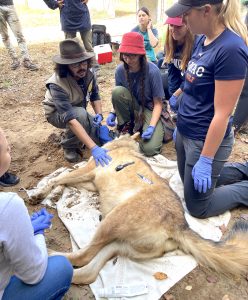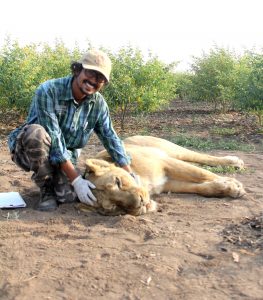
Course: Animal Behavior
Departments: Environmental studies and biology
Professor: Stotra Chakrabarti (@StotraChakraba2)
Why should I take this class?
To explore the fundamentals of animal behavior and use that foundation to understand how we can better manage and conserve animal biodiversity. This course asks: Why do animals behave the way they do? Why do lions have manes while leopards don’t? Why do elephants and bees live in groups? Why does your friendly neighborhood squirrel get so busy late in the fall and again in the spring? Why do certain wolves “fish” but others never learn the technique? Labs and field trips include hands-on experience to quantify behavior, develop ethograms, and understand species’ repertoires.
Motto
Watch and wonder! There are no stupid questions in Animal Behavior.

Fun fact
We make multiple visits to the Wildlife Science Center in Stacy, Minnesota, to observe, handle, process, and immobilize wolves, pumas, bears, and coyotes. Students observe these carnivores and learn how to quantify behavior in the wild through scan and focal sampling similar to what they have learned in class by watching videos of meerkats and lions. With staff assistance, students learn how to chemically immobilize wolves, take body measurements (weight, length, neck and chest girths, etc.), record vital signs (respiration, heart rate, capillary fill, temperature), and perform surgeries in the field by implanting heart rate-monitoring biologgers subcutaneously into the wolves to gather heart rate data and assess different behavioral states remotely.

Science communication
The course allows students to learn science communication through developing gists of reading papers and presenting them in six to seven tweets that include the use of memes, GIFs, etc. Students also develop creative lab reports. Examples include “dating profiles” of certain species to showcase mating systems and Zillow rental IDs for beaver dams to illustrate wolf/beaver predation. Science communication is as crucial as doing science.
Building community
In the lab, students work together in groups, which percolate through the whole class, so students work together as a community. We watch animal behavior/nature documentaries such as Jane, have dinner together, and work on assignments together. Class conversations regarding societal connotations such as race, ideologies, and inherent human biases are as important as the course content.
November 3 2021
Back to top





